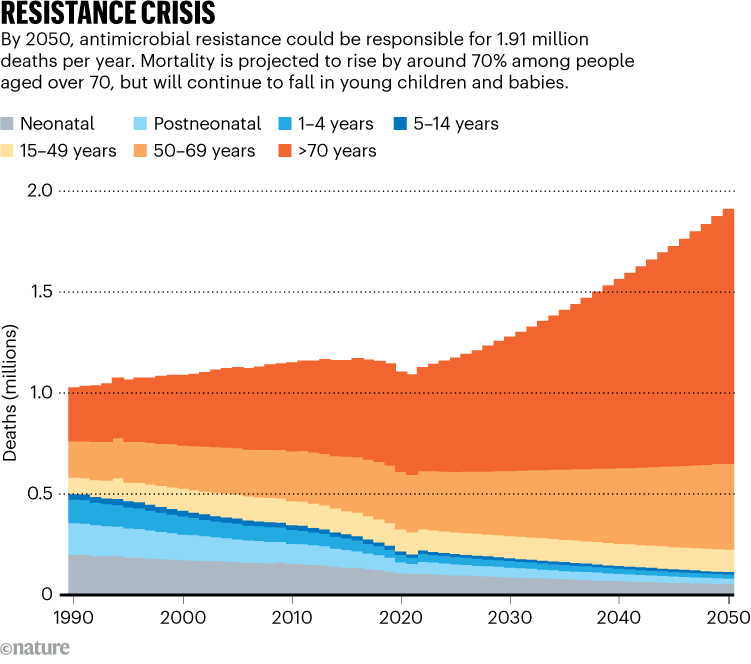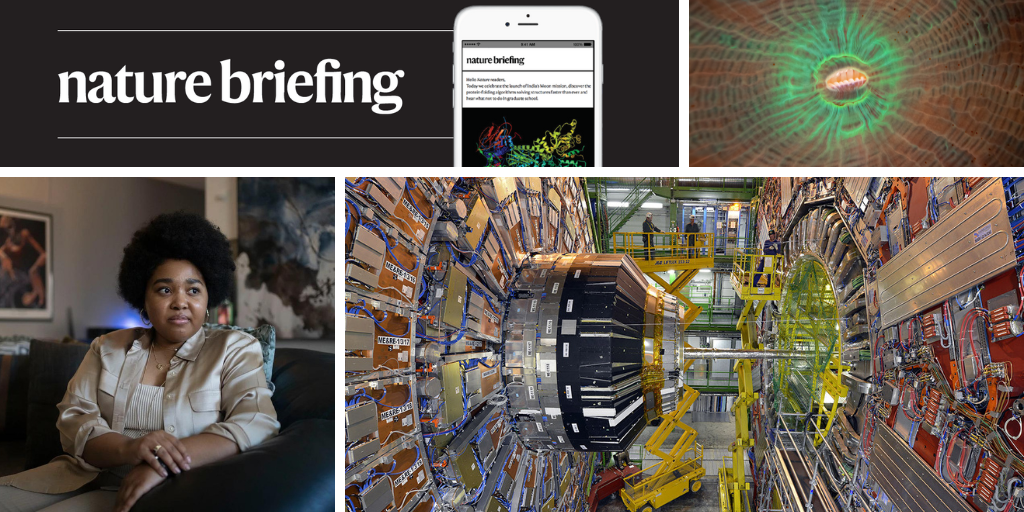Hello Nature readers, would you like to get this Briefing in your inbox free every day? Sign up here.

The CMS detector at CERN measured the decays of proton–proton collisions.Credit: Harold Cunningham/Getty
Researchers at CERN have calculated the mass of a fundamental particle called the W boson: 80,360.2 million electronvolts. The result quashes suggestions of a problem with the ‘standard model’ — physicists’ best description of particles and forces — raised by a discrepancy between the measured W boson mass and what the standard model predicts that was reported in 2022. “The standard model is not dead,” says particle physicist Josh Bendavid.
Tiny crustaceans called mysids (Hemimysis margalefi) can use ‘smell’ to find their way back from the open sea to the caves where they live. When placed in Y-shaped containers in which one arm contains seawater from their home cave, the shrimp-like creatures tended to opt for the water they were used to. Researchers showed that water from each cave had a unique chemical signature, which they suspect the mysids are using to find their way back in low-light conditions. “We found a true homing behaviour,” says marine ecologist and co-author Thierry Pérez. “Mysids are able to find a cave, but not any cave: [the] home cave, the cave where they were born.”
More than 39 million people could die from antibiotic-resistant infections between now and 2050, according to a report based on mortality data and hospital records from 204 countries. Researchers found that people in low- and middle-income countries are particularly at risk, in places where health systems can be bolstered and more can be done to prevent infections. “Most of these deaths do not actually require new or boutique interventions to be prevented,” says epidemiologist Joseph Lewnard.
Reference: The Lancet report

Source: Ref. 1
Features & opinion
In 2020, Genesis Jones was cured of sickle-cell disease with a blood stem cell transplant — but she still suffers from chronic pain caused by tissue and nerves that were damaged by the disease. “I feel like I’m in-between,” she says: she is turned away by some physicians because she’s disease-free and alienated from some of the support networks she relied on. Jones has formed her own support group, while clinicians are increasingly becoming aware of the need to offer continuing care. “You describe yourself as a sickle-cell warrior?” paediatric haematologist and oncologist Lakshmanan Krishnamurti asks his patients. “Your training to become a sickle-cell veteran starts now.”
A new UK funding agency for high-risk research modelled on the famed US Defense Advanced Research Projects Agency (DARPA) is up and running. The world’s research community is watching to see whether the Advanced Research and Invention Agency (ARIA) can achieve one of the most difficult tasks in research: creating truly revolutionary innovations. ARIA’s eight programme directors have had extraordinary freedom to define a research focus — from precision neurotechnologies to AI safety. Over four years, they have £800 million (US$1 billion) to dole out to scientists, technologists and businesses to develop world-changing technologies.
Increasingly, researchers looking to save money, protect confidentiality or ensure reproducibility are turning to large language models (LLMs) that they can run locally, instead of using online systems such as ChatGPT. Systems such as Microsoft’s Phi-3.5 and Google DeepMind’s Gemma-2 are small enough to be run on a local network or even on a smartphone. And ‘open weights’ versions of LLMs make the weights and biases used to train a model publicly available, so that users can fine-tune them for focused applications, if they have the computing power. Technology journalist Sharon Machlis wrote a guide to using LLMs locally, covering a dozen options. “The first thing I would suggest,” she says, “is to have the software you choose fit your level of how much you want to fiddle.”
Image of the week

Credit: Patrick Keeling
These bizarre, tooth-like structures are actually digestive tissues inside a tiny polyp of brain coral, captured using a specialized lens by biologist Patrick Keeling in his laboratory at the University of British Columbia in Vancouver, Canada. Coral reefs are made up of thousands of polyps, but a parasite is threatening their health by reducing their ability to survive bleaching — the loss of helpful algae from the corals’ tissues because of stressful conditions. Together with other researchers, Keeling is studying the parasite to better understand how to protect reefs.
See more of the month’s sharpest science shots, selected by Nature’s photo team. (Patrick Keeling)
Today I’m enjoying the tale of ham radio aficionado Maggie Iaquinto, who regularly chatted with cosmonauts on the Mir space station in the 1980s and 90s from her home in Australia —including keeping them up-to-date when the Soviet Union was dissolved in 1991.
I’d be delighted to receive your messages — especially your feedback on this newsletter. Please e-mail us at [email protected].
Thanks for reading,
Flora Graham, senior editor, Nature Briefing
With contributions by Jacob Smith
Want more? Sign up to our other free Nature Briefing newsletters:
• Nature Briefing: Careers — insights, advice and award-winning journalism to help you optimize your working life
• Nature Briefing: Microbiology — the most abundant living entities on our planet — microorganisms — and the role they play in health, the environment and food systems.
• Nature Briefing: Anthropocene — climate change, biodiversity, sustainability and geoengineering
• Nature Briefing: AI & Robotics — 100% written by humans, of course
• Nature Briefing: Cancer — a weekly newsletter written with cancer researchers in mind
• Nature Briefing: Translational Research — covers biotechnology, drug discovery and pharma


